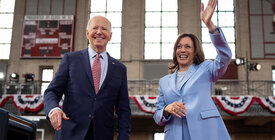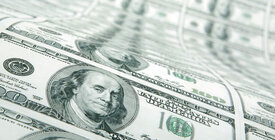With deep-pocketed donors around the country eager to steer the outcome of Pennsylvania’s Senate and toss-up House races, the state is set to have some of the most expensive elections in the nation.
Similar to races in Ohio that we recently profiled, Pennsylvania’s Senate and marquee House contests are notable for both the amount already spent on them and the source of the money. Overwhelming majorities of outside spending and campaign contributions alike have come from outside the Keystone State, continuing a trend in which campaign spending increasingly fuels and reinforces the nationalization of congressional elections. This increases the pressure elected officials feel to cater to a national audience of big donors rather than engaging with their constituents.
Out-of-state megadonors drive Senate spending
Like other competitive Senate races this year, Pennsylvania’s demonstrates how campaigns have increasingly come to rely on wealthy out-of-state individuals and super PACs for support. Though Pennsylvania did not see a contested primary battle like the GOP race in Ohio, its Senate race is already among the most expensive in the country.
The GOP nominee, former Bridgewater CEO Dave McCormick, ran unopposed. He narrowly lost the GOP nomination in 2022 to Mehmet Oz, who had former President Trump’s endorsement. But Trump endorsed McCormick this time, leaving donors aligned with GOP leadership free to support McCormick against Democratic incumbent Bob Casey Jr.
The largest outside spender so far is Keystone Renewal PAC, a pro-McCormick super PAC formed last August that has spent more than $17 million. Despite its name, the group has reported only two in-state donations totaling just over $1 million. The remaining 96 percent of its funding comes from donors around the country, including $10 million from Citadel hedge fund CEO Ken Griffin, the group’s largest benefactor; $2 million from fellow financier and conservative megadonor Paul Singer; and $1 million from American Advancement Inc., a dark money nonprofit organization that does not disclose its donors.
Americans for Prosperity Action, an arm of the Kansas-based Koch network that has no ties to Pennsylvania, is another top spender at $3.4 million for McCormick. The group’s largest contributors, which provide around 40 percent of its total funding, are Koch Industries and Stand Together Chamber of Commerce, a Virginia-based dark money group.
Casey has received support from national groups, too, though much less than McCormick — under $7 million so far. The largest pro-Casey spending has come from WinSenate PAC, a super PAC affiliated with Senate Democrats, and NRDC Action Votes, a super PAC focused on environmental issues that gets nearly all its funding from NRDC Action Fund, which does not disclose all of its donors.
Senate candidates raising money directly from large out-of-state donors
Analysis of the candidates’ FEC disclosures combined with data from the two largest online fundraising conduits — WinRed and ActBlue — helps to paint a picture of who is funding both the Republican and Democratic campaigns. It shows that the leading candidates are also getting most of their large donations from donors outside of Pennsylvania.
McCormick in particular has turned to large out-of-state donors for much of his direct fundraising. From January 1, 2023, through June 30, 2024, he raised $9.9 million. We estimate that $6.4 million, roughly 64 percent, of this total came from donors who gave $1,000 or more, with at least $4.4 million of these large contributions coming from out of state. Only about $2.2 million, or roughly 22 percent, of McCormick’s direct support so far has come from small donors who gave $200 or less.
For his part, Casey raised $19 million from individual donors. Nearly 50 percent of this total — $9.2 million — has come from donors who gave $1,000 or more, with more than $6 million of these donations coming from outside Pennsylvania. Casey has raised roughly $5.5 million, or 29 percent of his total so far, from small donors who gave $200 or less.
By contrast, Pennsylvania’s 2022 Senate contest — also a critical swing race — featured a higher proportion of small-dollar fundraising through the general election. Both candidates in that race raised similar proportions of their large contributions from outside Pennsylvania, but those donors made up smaller slices of the overall fundraising pie. Democrat John Fetterman took in about half of his $68 million from donations of $200 or less and only a quarter from donors who gave $1,000 or more. Oz raised far less overall, just $21 million, and relatively more from large donors, about 37 percent of his total — but small donations still accounted for about one-third of his total. He supplemented their giving by loaning his campaign $27 million.
Self-funding
Like Oz in 2022 and several high-profile Senate candidates this year, McCormick is relying significantly on his own money, having donated more than $4 million to his campaign so far. His self-financing represents nearly 23 percent of his campaign’s receipts and is almost double the total that he has received from small donors.
Nationalized House races
The same trends evident in the Senate contest have played out in several of Pennsylvania’s House primaries, but with an added wrinkle: in addition to the influence of big out-of-state money, outside groups appeared to cross party lines to meddle in their opponents’ races.
Brian Fitzpatrick, one of the more moderate Republicans in the House, benefited from the bulk of the $665,000 in independent expenditures that outside groups spent ahead of the April primary in his competitive suburban Philadelphia district. Supported by a variety of Republican organizations, including the Congressional Leadership Fund and Defending Main Street, Fitzpatrick won by a wide margin against far-right challenger Mark Houck. Interestingly, Houck’s only outside spending support was $100,000 from a left-leaning group called True Patriots PA. The group receives its funding from Promote the Vote, a 501(c)(4) nonprofit group that does not disclose its donors.
Pennsylvania’s Seventh Congressional District, located in the Lehigh Valley, is considered a toss-up by the Cook Political Report. Out of three Republicans vying to take on Democratic incumbent Susan Wild, Kevin Dellicker appeared to raise the most money from individual donors, but that advantage was erased by $490,000 in outside spending from the Koch network’s AFP Action in favor of the eventual winner, Ryan Mackenzie. As in Fitzpatrick’s race, the only significant outside group opposition to Mackenzie was $105,000 in cross-party spending from a pop-up super PAC called Integrity Leadership Fund that formed shortly before the primary. Since this organization was new, it did not have to disclose its donors before the primary took place — but it is now backing Wild in the general election.
The primary with the most outside spending was Bhavini Patel’s unsuccessful challenge against Democratic incumbent Summer Lee, a member of the progressive “Squad” who represents a safely blue district near Pittsburgh. Patel’s campaign was boosted by over $600,000 in independent expenditures from Moderate PAC, a single-candidate group that received most of its funding from Jeff Yass, an ultraconservative megadonor and Pennsylvania’s richest resident. Lee ultimately out-fundraised Patel and also received support from independent expenditures.
In addition to outside spending from national groups, winners of the most competitive primaries and many of their opponents relied heavily on campaign contributions from large donors who live outside their districts. As of the April primary, the race for the 1st congressional district had been especially reliant on such donors. Of Fitzpatrick’s $1.7 million, 90 percent came from donations of $1,000 or more and at least 94 percent from outside the district. His Democratic opponent, Ashley Ehasz, raised 74 percent of her $1.5 million from large donations and approximately three-quarters from outside the district. The biggest overall fundraisers, Democrats Wild and Lee, similarly received over three-quarters of their money from outside their districts, though they were slightly less reliant on large donors — 61 percent of Lee’s $2.3 million and 69 percent of Wild’s $2.9 million came from donations of $1,000 or more. The only exception was Mackenzie, who is an outlier both because he raised most of his money from donors within his district and because he raised far less than the others. Even so, 71 percent of his $236,000 came from large donors, and that was supplemented by nearly half a million dollars from the Koch network.
• • •
So far, Pennsylvania’s key races have demonstrated the extent to which congressional candidates typically must rely on a national donor class for both campaign fundraising and outside spending support, as well as the advantages candidates enjoy when they can tap into significant personal wealth for their campaigns. With control of both the House and Senate hinging on a handful of predictably competitive seats, the nationalization of our campaign finance system and its reliance on massive spending by the very wealthiest Americans are likely to continue — with an ever-greater divide between who funds campaigns and who candidates are running to serve.
This analysis used campaign finance data from the FEC, processed by Eric Manning and Open Secrets.
Methodology
The Brennan Center’s analysis compares contributions reported by candidates’ campaign committees with transactions reported by the fundraising conduits ActBlue and WinRed. Campaign committees report donations as itemized contributions when the contributor has given more than $200 to the candidate within the election cycle and as aggregated unitemized totals for smaller amounts. The fundraising conduits report transactions as itemized contributions regardless of amount. By comparing these reports, eliminating duplicate transactions, and identifying repeat contributors to the same candidate within the same cycle, we gain insight into the source of campaigns’ unitemized totals.
However, there remains a pool of “unknown” unitemized money that does not flow through the conduits, about which we do not know the donations’ timing, size, or source. We estimate the proportions of this pool of money contributed by small, medium, and large donors based on the observed overall proportion of known unitemized contributions coming from small, medium, and large contributors across all races for the same chamber within the same election cycle. This yields a “best-guess” estimate of how much unknown unitemized money comes from small, medium, and large donors. For pre-primary fundraising totals in 2024 House races, we estimate how much unknown unitemized money from the campaigns’ July quarterly disclosure came in before the primary based on the proportion of all “known” unitemized fundraising reported by the conduits before the primary date. To assess the proportion of money that candidates raise from within their district or state, we rely on the zip codes or states disclosed by campaigns and conduits. For House races, if the donor’s zip code overlaps with the candidate’s district, we counted their contribution as in-district. A small number of transactions lack a valid zip code or state; we do not count these transactions as in- or out-of-district or state.





